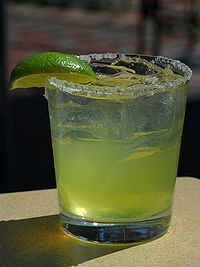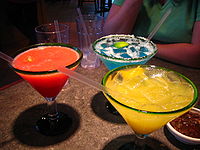- Margarita
-
For other uses, see Margarita (disambiguation).
Margarita IBA Official Cocktail 
Type Mixed drink Primary alcohol by volume Served On the rocks; poured over ice Standard garnish IBA specified ingredients* - 35 ml (seven parts) tequila
- 20 ml (four parts) Cointreau or Triple Sec
- 15 ml (three parts) lemon or lime juice
Preparation Rub the rim of the glass with the lime slice to make the salt stick to it. Shake the other ingredients with ice, then carefully pour into the glass (taking care not to dislodge any salt). Garnish and serve over ice. * Margarita recipe at International Bartenders Association The margarita is a cocktail consisting of tequila mixed with orange-flavoured liqueur and lime or lemon juice, often served with salt on the glass rim. It is the most common tequila-based cocktail in the United States.[1] The drink is served shaken with ice, on the rocks, blended with ice (frozen margarita) or without ice (straight up).
Contents
Variations
The IBA (IBA Official list of Cocktails) standard is 7:4:3, that is, 50% tequila, 29% Cointreau, 21% fresh lime or lemon juice.[2]
Flavored liqueurs
Orange-flavored liqueurs that might be used include triple sec, blue curaçao yielding the blue margarita. When sweeter fruit juices or freshly puréed fruits are added to the margarita, the amount of orange-flavored liqueur is often reduced or eliminated entirely. In addition to orange-flavored liqueurs, secondary liqueurs may occasionally be added to the cocktail, including melon-flavored or black raspberry-flavored.
Fresh lime juice
Freshly squeezed lime juice is the key ingredient. The most common lime in the U.S. is the thick skinned Persian lime. However, margaritas in Mexico are generally made with Mexican limes (Key limes). These are small, thin skinned limes and have a more tart and an often bitter flavor compared to Persian limes. Margaritas made with lemon have a softer taste, especially when Meyer lemons are used.[citation needed]
Other fruits
Alternate fruits and juice mixtures can also be used in a margarita. Many recipes call for a splash of orange juice. When the word "margarita" is used by itself, it typically refers to the lime or lemon juice margarita, but when other juices are used, the fruits are typically added as adjectives in the name; with lime juice or lemon juice added to give it a characteristic margarita flavor (a wedge of lime is often added to the glass).
History
 A margarita served in an old fashioned glass.
A margarita served in an old fashioned glass.
Origin
There is no solid proof who "invented" the Margarita.[3] The most accepted of all stories is that the Margarita was invented in October 1941, at Hussong's Cantina[4] in Ensenada, Mexico, by bartender Don Carlos Orozco.[5] One slow afternoon, Don Carlos was experimenting with mixing new drinks when a prestigious visitor arrived: Margarita Henkel, the daughter of a German ambassador, who lived with her husband Roy Parodi near the city in Rancho Hamilton. Don Carlos offered the drink to Margarita, and named it after her for being the first person to taste it.[6] He concocted a mixture of equal parts tequila, orange liqueur and lime, served over ice in a salt-rimmed glass.[7]
Another common story related the Margarita being invented a few years earlier at the Rancho La Gloria Hotel, halfway between Tijuana and Rosarito, Mexico, by Carlos "Danny" Herrera, for a former Ziegfeld dancer named Marjorie King.[8] This story was related by Herrera and also by bartender Albert Hernandez, who is acknowledged for popularizing the Margarita in San Diego after 1947, at the La Plaza restaurant in La Jolla.[9] Hernandez claimed the owner of La Plaza, Morris Locke, knew Herrera and visited Mexico often.
Another common origin tale begins the cocktail’s history at the legendary Balinese Room in Galveston, Texas where, in 1948, head bartender Santos Cruz created the Margarita for singer Peggy Lee. He supposedly named it after the Spanish version of her name, Margarita, and it’s been a hit ever since. [10]
The most plausible explanation, however, is that the Margarita is merely a popular American drink, the Daisy, remade with tequila instead of brandy, which became popular during Prohibition as people drifted over the border for alcohol. There is an account from 1936 of Iowa newspaper editor James Graham finding such a cocktail in Tijuana, years before any of the other Margarita "creation myths".[11] Margarita is Spanish for Daisy. It is likely that Orozco and Herrara merely perfected the "Tequila Daisy".
Glass
Margaritas may be served in a variety of glasses, most notably the stereotypical margarita glass, a variant of the classic Champagne coupe; this is particularly associated with blended fruit margaritas, and the glass is also used for dishes such as guacamole or shrimp cocktails. In formal settings margaritas are often served in a standard cocktail glass, while in informal settings, particularly with ice, margaritas may be served in an old-fashioned glass.
Popularity
The margarita cocktail was the "Drink of the Month" in Esquire magazine, December 1953, pg. 76:[12]
- 1 ounce tequila
- Dash of Triple Sec
- Juice of 1/2 lime or lemon
- Pour over crushed ice, stir. Rub the rim of a stem glass with rind of lemon or lime, spin in salt—pour, and sip.
See also
- Alcohol
- List of cocktails
- Paloma
References
- ^ The most popular tequila cocktail in Mexico, by contrast, is the paloma.
- ^ "IBA recipe". IBA. http://www.iba-world.com/english/cocktails/margar.php. Retrieved 2 November 2011.
- ^ "Once Upon a Time in Mexico - The Origin of the Margarita". Imbibe Magazine. March/April 2010. http://imbibe.com/article/once-upon-time-in-mexico. Retrieved 30 June 2011.
- ^ cantinahussongs.com
- ^ de Mancillas, Gloria (1992). Seminario de Historia de Baja California. Instituto de Investigaciones Historicas UABC.Hazard, Ann (1992). Agave Sunsets, Treasured Tales of Baja. Renegade Enterprises, pp 157-160.Lieber, Sara (2007). MTV Vest of Mexico. Wiley Publishing, Inc., p 349.
- ^ de Mancillas, Gloria (1992). Seminario de Historia de Baja California. Instituto de Investigaciones Historicas UABC.Hazard, Ann (1992). Agave Sunsets, Treasured Tales of Baja. Renegade Enterprises, pp 157-160.Lieber, Sara (2007). MTV Vest of Mexico. Wiley Publishing, Inc., p 349.
- ^ de Mancillas, Gloria (1992). Seminario de Historia de Baja California. Instituto de Investigaciones Historicas UABC.Hazard, Ann (1992). Agave Sunsets, Treasured Tales of Baja. Renegade Enterprises, pp 157-160.Lieber, Sara (2007). MTV Vest of Mexico. Wiley Publishing, Inc., p 349.
- ^ Michael Stetz (9 July 2006). "I'll Have a Mystery on the Rocks with Salt". San Diego Union-Tribune. http://www.signonsandiego.com/uniontrib/20060709/news_1m9marg.html. Retrieved 30 June 2011.
- ^ Jack Williams (4 May 2006). "Obituary - Albert Hernandez Sr.; Margarita Pioneer, Restaurateur". San Diego Union-Tribune. http://www.signonsandiego.com/uniontrib/20060504/news_1m4hernandez.html. Retrieved 30 June 2011.
- ^ Rosenberg Library Museum "Lost Treasure: The Balinese Room" Balinese Room. .
- ^ David Wondrich (5 May 2010). "Behind the Drink: The Margarita". Liquor.com. http://liquor.com/liquor/articles/behind-the-drink-the-margarita/. Retrieved 30 June 2011.
- ^ Barry Popik. "Texas, The Lone Star State: Margarita (cocktail)". http://www.barrypopik.com/index.php/texas/entry/margarita_cocktail/. Retrieved 12 August 2006.
External links
Frozen beverages Coolatta • Daiquiri • Frappuccino • Ice cream soda • Margarita • Orange Whip • Slurpee • Slush (beverage) • Slush Puppie
Categories:- Cocktails with tequila
- Cocktails with triple sec or curaçao
- Frozen beverages
- Mexican alcoholic beverages
Wikimedia Foundation. 2010.




